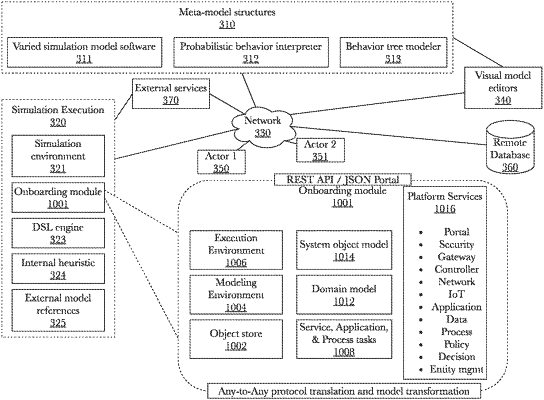| CPC G06F 30/20 (2020.01) [G06F 8/10 (2013.01); G06F 9/448 (2018.02); G06N 7/01 (2023.01); G06Q 10/0637 (2013.01); H04L 67/02 (2013.01); G06N 5/01 (2023.01)] | 10 Claims |

|
1. A system for creating and executing domain-specific language and abstract meta-model simulations, comprising:
a computing device comprising a memory, a processor, a non-volatile data storage device, and a display device;
an onboarding module comprising a first plurality of programming instructions stored in the memory and operating on the processor, wherein the first plurality of programming instructions, when operating on the processor, cause the computing device to:
determine a context of one or more declarative interactions based on metadata;
transform two or more base objects into two or more interpreted objects by interpreting the two or more base objects based on evaluation of the context, and by resolving references of the two or more base objects relative to domain model types and concepts;
chain at least two of the two or more interpreted objects based on a particular post-condition of a particular interpreted object of the at least two of the two or more interpreted objects; and
store the chained objects in an appropriate domain model;
a domain-specific language engine comprising a second plurality of programming instructions stored in the memory and operating on the processor, wherein the second plurality of programming instructions, when operating on the processor, cause the computing device to:
retrieve domain knowledge of a domain model from the onboarding module, wherein the domain knowledge comprises one or more chained objects;
create a plurality of knowledge models based on the domain knowledge, wherein the domain-specific concepts are created in one or more functions and one or more attributes;
create one or more domain-specific concepts from the plurality of knowledge models;
map the selected design pattern to the one or more domain-specific concepts to obtain a domain meta-model; and
translate each element of the obtained domain meta-model into a plurality of keywords;
create grammar of the domain-specific language from the plurality of keywords;
create a domain-specific simulation model based on the domain-specific language, the domain-specific simulation model comprising actors, objects, and events, and a plurality of behaviors of the actors, the objects, and the events within a specific application domain;
a probabilistic behavior interpreter comprising a third plurality of programming instructions stored in the memory and operating on the processor, wherein the third plurality of programming instructions, when operating on the processor, cause the computing device to:
calculate probabilistic behavior results based on the behaviors of the actors, objects, and events of the domain-specific simulation model, wherein the probabilistic behavior results include environment interactions, specific behaviors, and outcomes of the specific behaviors;
store the probabilistic behavior results as a behavior tree model;
a meta-model constructor comprising a fourth plurality of programming instructions stored in the memory and operating on the processor, wherein the fourth plurality of programming instructions, when operating on the processor, cause the computing device to:
create a meta-model specification from the domain-specific simulation model and the behavior tree model;
receive a modification of the meta-model specification; and
a meta-model simulation execution environment comprising a fifth plurality of programming instructions stored in the memory and operating on the processor, wherein the fifth plurality of programming instructions, when operating on the processor, cause the computing device to:
execute the meta-model simulation based on the modified meta-model specification; and
an internal heuristic comprising a sixth plurality of programming instructions stored in the memory and operating on the processor, wherein the sixth plurality of programming instructions, when operating on the processor, cause the computing device to:
receive data from the meta-model simulation when the meta-model simulation is being executed;
receive an input from a user when the user is connected to the meta-model simulation being executed as an active actor; and
alter the simulation environment of the meta-model simulation being executed in response to the data from the meta-model simulation and the input from the user by parameterizing specific discrete objects, events, and actors in the received data of the meta-model simulation being executed.
|